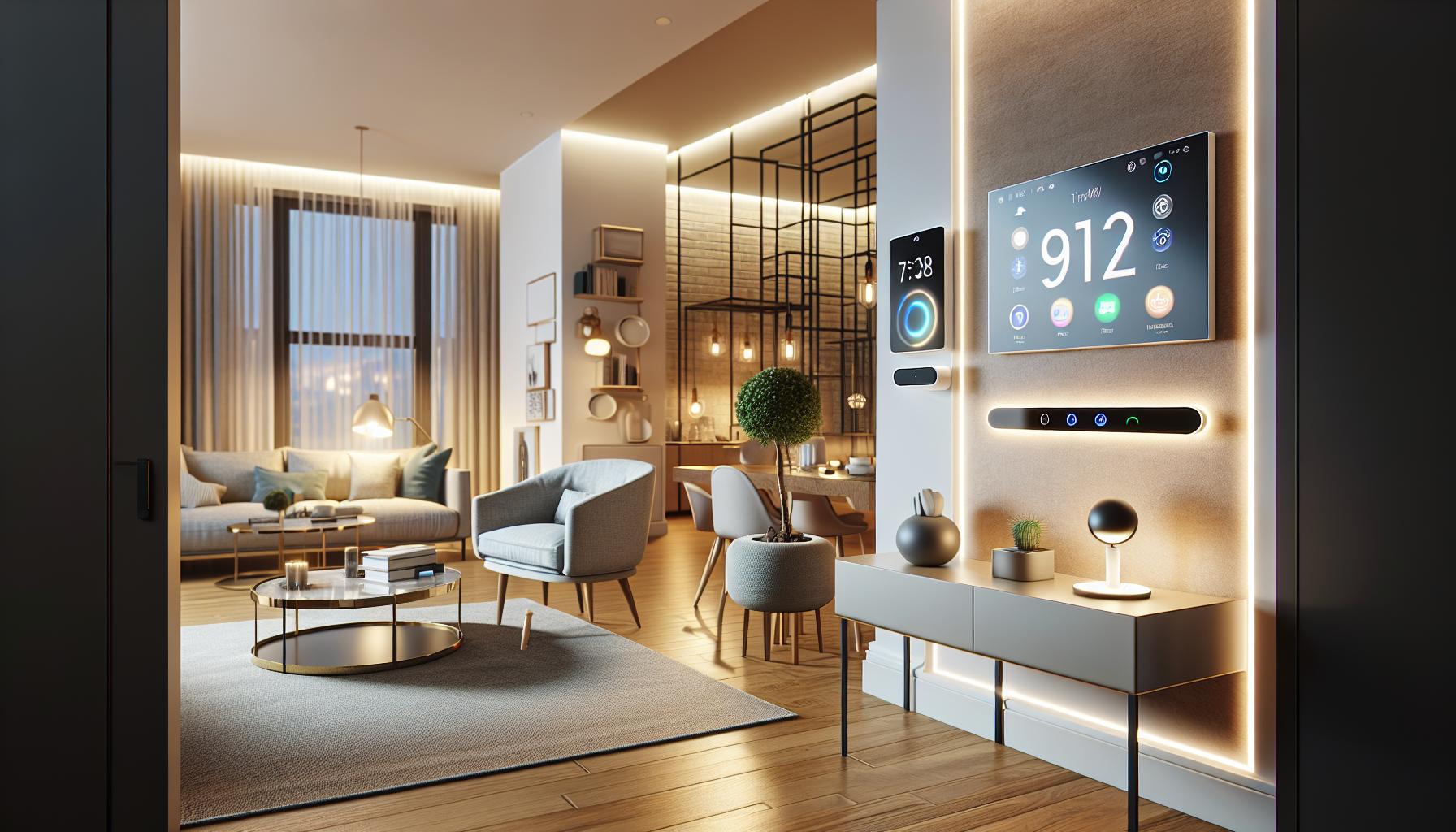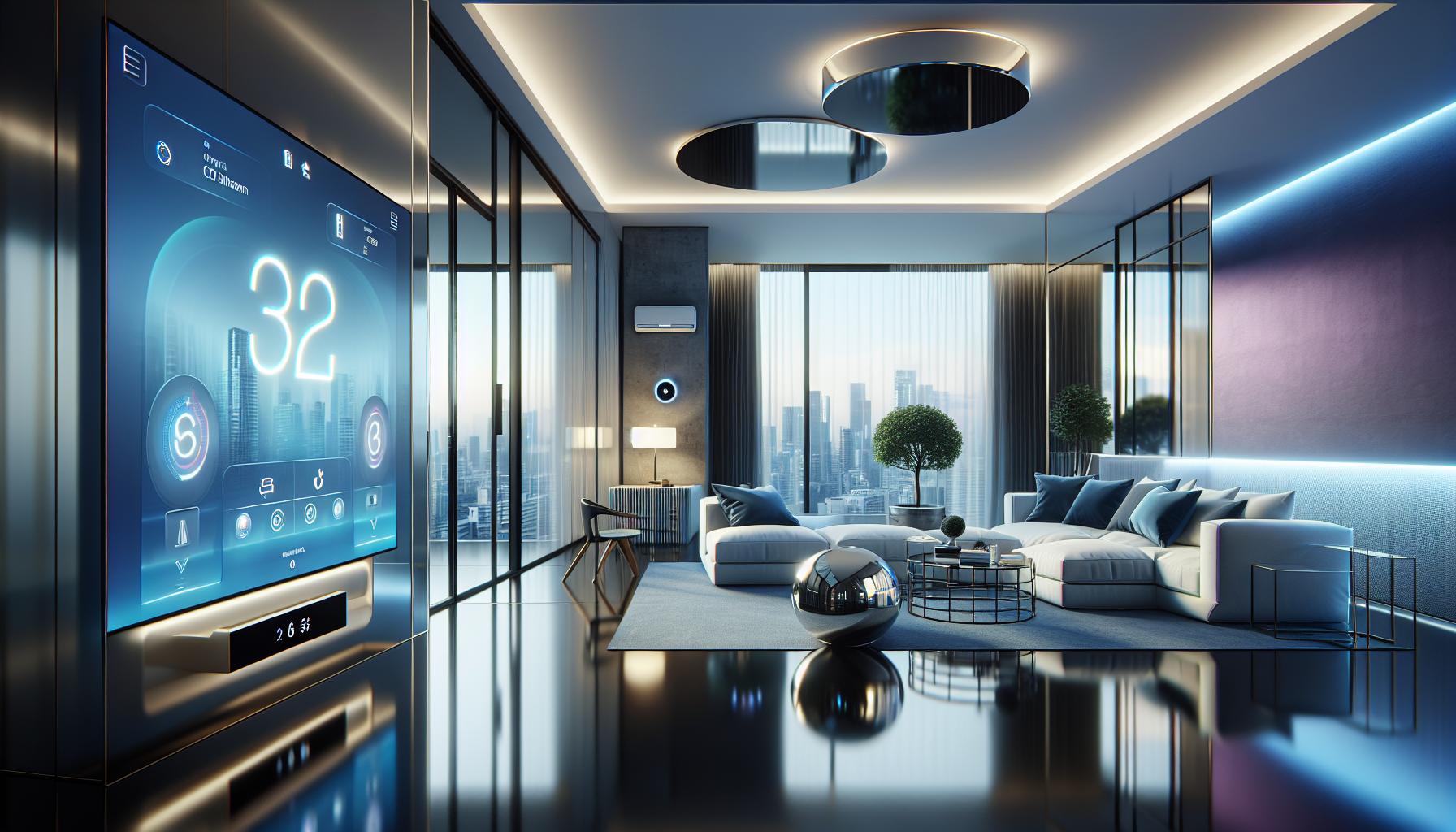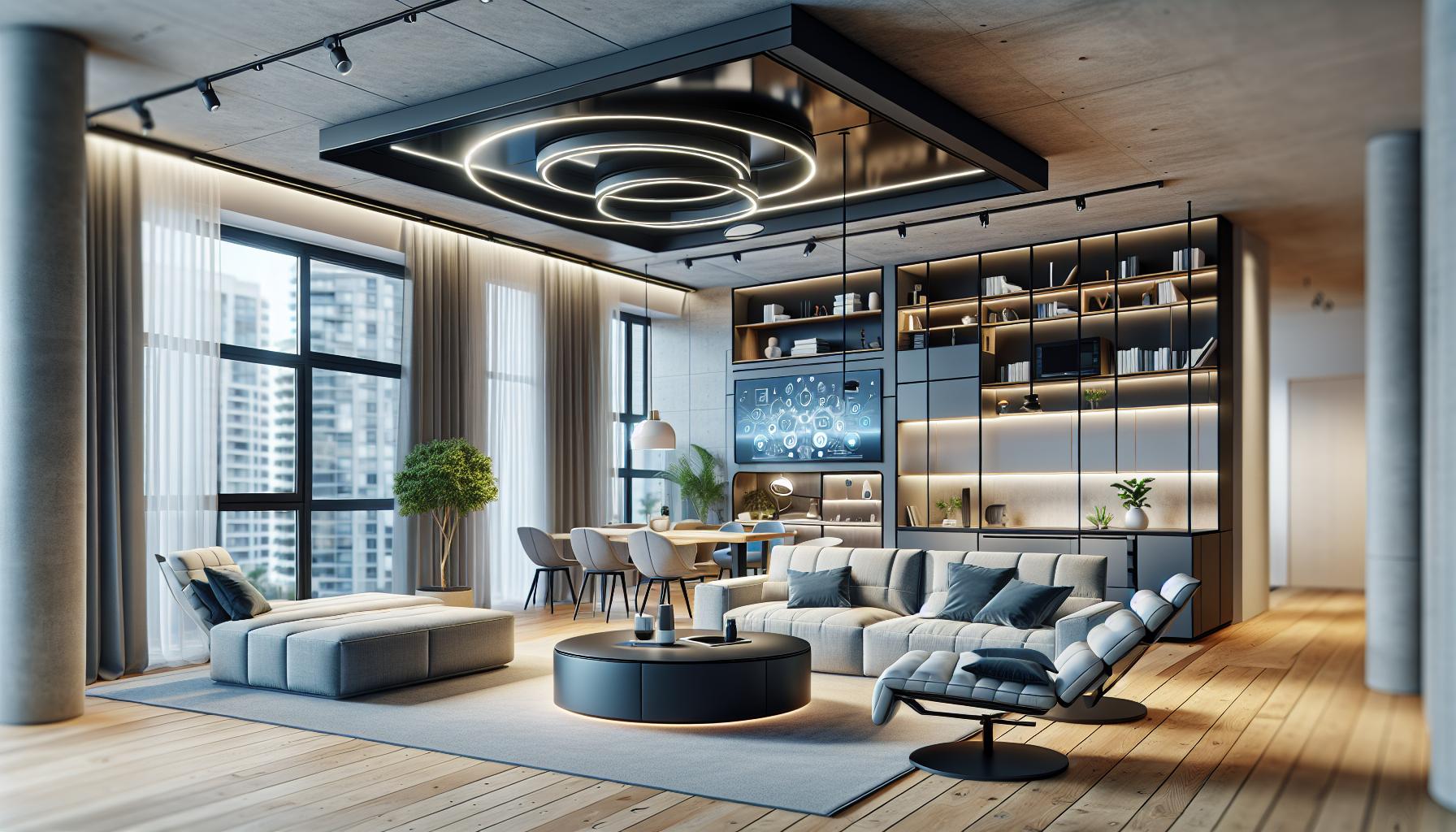Key Takeaways
- Smart Home Technology Enhances Living: Integrating smart technology into apartment spaces improves convenience, energy efficiency, and overall quality of life, transforming ordinary living into a modern experience.
- Key Smart Devices to Consider: Essential devices like smart lighting, smart thermostats, and smart security systems are crucial for optimizing apartment features and enhancing comfort and security.
- Sustainability Benefits: Smart home solutions promote sustainability by reducing energy consumption through automated systems, resulting in lower utility bills and a more eco-friendly lifestyle.
- Innovative Design Ideas: Incorporating open floor plans and multi-functional furniture increases space efficiency and empowers smart device integration, creating a cohesive and stylish living environment.
- Strategic Implementation Tips: To maximize benefits, assess needs, prioritize key areas, and establish a clear budget while planning for future upgrades in smart home technology.
In today’s fast-paced world, smart home technology is transforming how people live, even in cozy apartments. With the right gadgets and design ideas, anyone can create a convenient and efficient living space that enhances their lifestyle. From energy-saving devices to automated systems, the possibilities are endless.
Imagine controlling your lights, thermostat, and security all from your smartphone. Smart home solutions not only offer comfort but also promote sustainability and security. Whether it’s optimizing small spaces or integrating cutting-edge technology, these smart home apartment ideas will inspire residents to embrace a modern, connected lifestyle.
Smart Home Apartment Ideas
Smart home technologies transform living spaces into efficient, convenient environments. Implementing gadgets like smart speakers enhances connectivity and provides voice control over devices. Smart lighting systems grant the ability to customize ambiance with automated schedules and remote access.
Smart thermostats optimize energy usage, adjusting temperatures based on resident habits, resulting in significant cost savings. Smart security systems increase safety, offering features such as video surveillance and smart locks that provide remote monitoring capabilities.
Incorporating smart appliances, like refrigerators and ovens, simplifies daily chores, allowing users to control functions from their phones. Smart home hubs centralize control of various devices, streamlining operation into a single interface.
Design considerations also play a critical role. Multi-functional furniture blends seamlessly with technology, maximizing space while maintaining style. Open layouts enhance functionality, enabling easy placement of devices throughout the apartment.
These innovations foster a modern lifestyle, catering to comfort and sustainability while redefining living experiences in urban settings.
Benefits of Smart Home Technology

Smart home technology offers numerous advantages for apartment living, significantly enhancing daily experiences. It fosters greater convenience and efficiency, ultimately improving overall quality of life.
Enhancing Convenience
Smart home technology streamlines daily tasks, making life more manageable. Smart assistants, like Amazon Echo or Google Nest, simplify communication with devices using voice commands. Smart locks provide keyless entry, allowing residents to control access remotely. Automated lighting adjusts based on occupancy, ensuring a welcoming atmosphere while conserving energy. Homeowners can schedule appliances, such as coffee makers or washers, to operate at preferred times, aligning with their routines. Sensors alert users to unusual activity, enhancing security with minimal effort.
Improving Energy Efficiency
Smart home technology significantly reduces energy consumption, promoting sustainability. Smart thermostats, such as Nest or ecobee, learn user preferences and adjust heating or cooling to optimize energy usage. Automated lighting systems can change brightness levels and colors based on time of day, reducing electricity bills. Smart plugs and switches allow for remote control of devices, ensuring they’re turned off when not in use. Energy monitoring systems track consumption patterns and suggest savings tips, empowering users to make informed decisions. These features contribute to a more eco-friendly living environment, lowering both bills and environmental impact.
Essential Smart Devices for Apartments

Smart devices enhance apartment living by offering convenience, efficiency, and automation. Several key categories of smart devices can significantly improve everyday experiences.
Smart Lighting Solutions
Smart lighting solutions provide customizable brightness and color temperature options for improved ambiance. Users can control lights remotely via smartphones or through voice assistants. Popular products include smart bulbs from Philips Hue and LIFX, which enable scheduled lighting, scenes, and dimming. Also, motion sensors can automate lighting, ensuring lights activate when someone enters or exits a room.
Smart Thermostats
Smart thermostats optimize energy usage by learning daily schedules and adjusting temperatures accordingly. Products like the Nest Learning Thermostat and Ecobee SmartThermostat allow users to control settings remotely and monitor energy consumption. Additionally, these devices can integrate with HVAC systems to enhance efficiency and maintain comfort while reducing energy bills.
Smart Security Systems
Smart security systems bolster apartment security through various interconnected devices. Features include smart locks, surveillance cameras, and alarm systems. Brands like Ring and Arlo offer comprehensive solutions that enable remote monitoring and alerts via smartphones. These systems provide peace of mind, allowing residents to secure their apartments with ease and respond to any suspicious activity instantly.
Innovative Design Ideas

Innovative design ideas enhance smart home apartments, maximizing functionality and comfort in limited spaces. Through careful planning and strategic integration of smart technology, residents can create an efficient living environment.
Open Floor Plan Incorporation
Open floor plans foster an airy, connected atmosphere, allowing for seamless navigation between living spaces. Incorporating smart lighting to adjust brightness based on time of day enhances this design. Smart speakers can serve as central hubs, controlling different areas with voice commands. Utilizing sliding partitions provides flexible space management, letting residents adjust the layout as needed while maintaining a modern aesthetic.
Multi-Functional Furniture
Multi-functional furniture optimizes space, combining several uses into one piece. Examples include sofas that convert into beds or coffee tables with built-in storage. Smart furniture, such as desks with integrated wireless charging pads or lighting, further elevates functionality. By selecting pieces that adapt to various needs, residents can achieve both style and practicality while minimizing clutter in their smart home apartments.
Tips for Implementation
Implementing smart home technology in an apartment requires strategic planning and budgeting. These steps ensure a seamless integration of smart devices while maximizing benefits.
Planning Your Smart Home Setup
- Assess Needs: Determine specific requirements for comfort, security, and convenience. Identify which devices align with lifestyle preferences and daily routines.
- Create a Layout: Develop a floor plan highlighting optimal locations for smart devices, such as speakers and sensors. Consider the connectivity range of devices during placement.
- Choose Compatible Ecosystems: Select devices that work well together, ensuring compatibility across brands. This facilitates centralized control through smart hubs or apps.
- Prioritize Key Areas: Focus on essential areas first, like the living room and kitchen. These spaces often benefit most from smart lighting, appliances, and security features.
- Plan for Future Expansion: Leave room for potential upgrades or additions, such as smart blinds or home automation systems. Choosing devices with upgrade paths guarantees long-term functionality.
- Set a Clear Budget: Establish a financial limit for smart home projects, taking into account both initial investments and ongoing expenses for subscriptions or services.
- Research Device Costs: Investigate prices for desired devices across multiple retailers. Compare features and check for discounts or bundles that maximize value.
- Consider Energy Savings: Evaluate smart devices that offer energy-efficient options, like smart thermostats. Over time, savings on energy bills can offset initial costs.
- Allocate for Installation: Budget for professional installation if necessary, particularly for more complex systems like smart security or lighting solutions.
- Account for Upgrades: Anticipate potential future upgrades when budgeting. Investing in premium devices with advanced features often proves beneficial.
Embracing Smart Home Technology
Embracing smart home technology transforms apartment living into a seamless experience. By integrating innovative devices and design ideas, residents can enhance comfort and security while promoting sustainability. The right combination of smart appliances and multi-functional furniture creates a harmonious living space that maximizes efficiency.
As urban living continues to evolve, the importance of a connected lifestyle becomes increasingly clear. With careful planning and strategic investment in smart solutions, anyone can enjoy the benefits of a modern home. Adopting these smart home apartment ideas not only improves daily life but also paves the way for a more sustainable future.